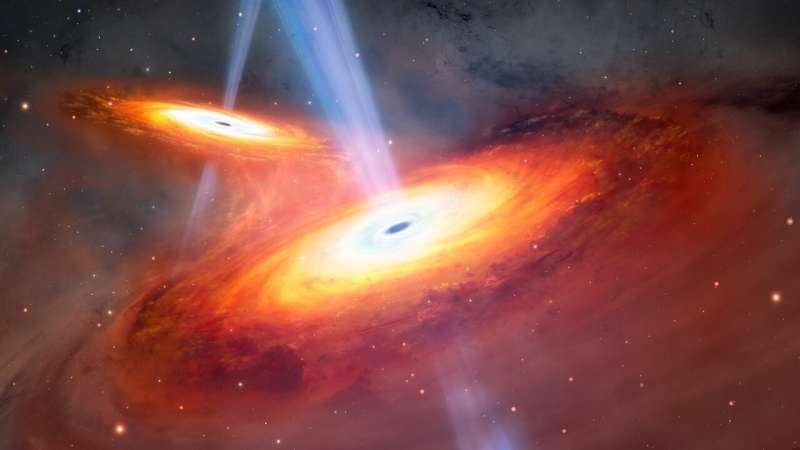This article has been reviewed according to Science X's editorial process and policies. Editors have highlighted the following attributes while ensuring the content's credibility:
fact-checked
peer-reviewed publication
trusted source
proofread
The earliest merging quasars ever seen

Studying the history of science shows how often serendipity plays a role in some of the most important discoveries. Sometimes, the stories are apocryphal, like Newton getting hit on the head with an apple. But sometimes, there's an element of truth to them.
That was the case for a new discovery of the oldest pair of merging quasars ever discovered—and it all started with a pair of red blots on a picture.
Those red blots were on a very particular picture—one taken by the Hyper Subprime-Cam on the Subaru telescope in Manuakea, Hawai'i. Yoshiki Matsuoka of Ehime University in Japan, who was manually reviewing the picture with colleagues, noticed two faint red splotches.
Unlike an automated algorithm, which might have overlooked them, he was interested in what might have caused them and decided to look closer.
To do so, he recruited another instrument on the Subaru telescope, known as the Faint Object Camera and Spectrograph, and the Gemini Near-Infrared Spectrograph on the neighboring Gemini North telescope.
After combing through this more targeted data, Dr. Matsuoka and his colleagues found something no one had seen before—a pair of merging quasars from less than a billion years after the universe was created. Their research is published in The Astrophysical Journal Letters.
Quasar mergers were theorized to happen all the time during that period, but despite having found 300 separate quasars around the same time frame, astronomers had yet to find any pairs. This was important because that time period, known as the Epoch of Reionization, was key in creating the structure of the modern-day universe.
During the Epoch of Reionization, energy, potentially from merging quasars, stripped the free-floating hydrogen abundant in the early universe of its electrons in a process called ionization.
About 1 billion years after the Big Bang and the theoretical end of the Epoch of Reionization, the structure of the modern universe was largely settled, and it had officially moved out of the period known as the "cosmic dark ages."
Understanding this period is critical for theorizing how the universe formed. Astronomers had long thought that merging quasars would have been common in the period, as supermassive black holes were relatively close, and structures were still working themselves out. So, the lack of them in experimental data was concerning.
Enter the pair found by Dr. Matsuoka and his colleagues. They appear about 900 million years after the Big Bang, still well within the Epoch of Reionization. However, collecting data on them wasn't easy, as old objects suffer from contamination in their signals, such as gravitational lensing and stars in the foreground. The researchers eventually found that some of the optical light wasn't directly coming from the quasars but rather the formation of stars around them.
However, the quasars were massive behemoths, weighing more than 100 million times more than our sun. They also had a bridge of gas connecting them, implying that the two galaxies they formed the core of were undergoing a massive merger, which we will now get to observe as it happens.
That merger is going to take millions, if not billions, of years, though, so it might be some time before we see the full effect. But in the meantime, cosmologists can start studying this quasar pair in earnest to see what other details can be gleaned about the Epoch of Reionization or the formation of the universe more generally. And it will all happen because someone noticed some red blots on a picture and decided to investigate further.
More information: Yoshiki Matsuoka et al, Discovery of Merging Twin Quasars at z = 6.05, The Astrophysical Journal Letters (2024). DOI: 10.3847/2041-8213/ad35c7
Journal information: Astrophysical Journal Letters
Provided by Universe Today





















